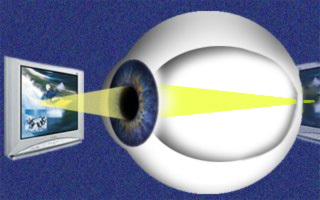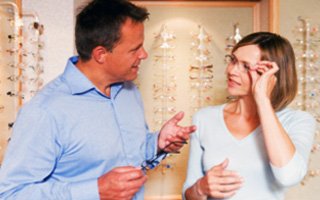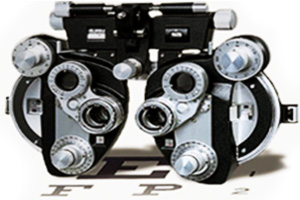| |
| |
| |
| |
| |
| |
| |
|
|
| |
| OFFICE HOURS
|
| |
| Monday: |
8:00 - 5:00 |
| Tuesday: |
8:00 - 5:00 |
| Wednesday: |
8:00 -
5:00 |
| Thursday: |
8:00 - 5:00 |
| Friday: |
8:00 - 5:00 |
| |
|
|
|
| |
|
Presbyopia
Presbyopia is an aging condition where the lens of the eye loses its ability to focus. The lens is the part of the eye that works with the cornea
to focus light on the retina. When the lens, cornea and retina
work together correctly, the result is a clear, sharp image.
Presbyopia, is also known as the "short arm syndrome", is a
term used to describe an eye in which the natural lens can no
longer accommodate.
Accommodation is the eye's way of
changing its focusing distance: the lens thickens, increasing
its ability to focus close-up. From the day we are born, our
ability to focus up close starts to diminish. |
 |
|
At about the age of 40, the lens becomes less flexible and accommodation
is gradually lost. It's a normal process that everyone eventually
experiences. In presbyopia, the lens is weakened, producing blurry
images.
Causes
Presbyopia is a natural
part of aging and affects everyone eventually. As the eye ages, the
elasticity of the lens decreases and the lens itself may thicken. The
ciliary muscles that hold the lens in place also decrease in elasticity.
These changes are believed to cause trouble with near vision.
Onset
and Treatment
Presbyopia will affect everyone, but usually
not until age 40. At that point, the eyes’ ability to focus decreases
gradually. Even if the patient has never had any vision problems
previously, they will develop presbyopia. Nearsighted people also
develop presbyopia, even though they are used to having good near
vision. A nearsighted person may find they need to hold a newspaper or
tablet at arm’s length to see it, just like any other person developing
presbyopia.
Another symptom of presbyopia is eye strain when
performing close work, such as typing. Bifocals are the common treatment
for presbyopia. Bifocal lenses have two points of focus, one for
distance and one for near vision. The distance vision portion takes up
the main part of the lens, with the near vision portion at the bottom in
a little box. Progressive addition lenses are another kind of lens that
can be used for presbyopia. They are similar to bifocals, with more of a
gradual transition between the two points of focus. Multifocal contact
lenses can also be prescribed.
Reading glasses can also be worn for
presbyopia and are normally only worn for close work. If the
patient already uses contact lenses, the doctor can prescribe
reading glasses that can be combined with their contacts.
It is possible to develop presbyopia before age forty. Early
development of presbyopia is known as premature presbyopia.
Farsightedness and some diseases such as diabetes and muscular
sclerosis are risk factors for premature presbyopia.
In
addition, some prescription drugs like antidepressants and
antihistamines can inhibit the eyes’ ability to focus. |
 |
Treatment
Reading glasses, bifocals or
progressive lenses. Some people are concerned that wearing reading
glasses will weaken the eyes. Because the process is continuous, our
need for reading glasses will increase whether we wear them or not and
whether we like it or not. The reading glasses do not weaken our eyes.
Advanced Treatment
Advanced treatments for
presbyopia include a couple surgical options:
•
Conductive keratoplasty: A non-laser refractive surgery that
reshapes the cornea using low-level radio frequency energy. The tissue
at the site of the application shrinks and tightens the cornea, changing
the curvature and producing clear near vision. The correction is
temporary, and will diminish over time.
•
Laser eye surgery: A surgical procedure where vision is corrected by
removing a small part of the eye with a laser. Using a highly focused
laser beam, a professional cuts away a bit of eye tissue, flattening the
cornea and correcting the focus. Patients with presbyopia undergoing
laser eye surgery can be given monovision, a method where one eye is
corrected for near vision and one eye is corrected for far vision.
•
Refractive lens replacement surgery: A surgical procedure where the
natural lens of the eye is removed and replaced with an artificial lens.
This allows vision to be corrected at all distances.
Diagnosis
A
diagnosis of presbyopia can be made during the course of a
comprehensive eye exam. A machine called a phoropter allows the doctor to show a series of lenses
to a patient, switching back and forth between them to determine
the best fit for corrective lenses.
Reading glasses are a
common solution for mild presbyopia. You can purchase reading
glasses at drug store, but they are only temporarily effective
because the lenses are not your prescription and over time that
may do more harm than good.
Because the lens of the eye
is slowly changing over time, periodic examinations are needed
to update corrective lenses. |
 |
Prevention
Since it is a
natural part of the aging process and not a disease, there are no
preventative measures for presbyopia. Maintaining overall health as a
means to eye health is always recommended. Fruits and vegetables high in
vitamins A, C and E are key foods for eye health.
Taking frequent
breaks while doing close work allows the ocular muscles to unwind. Try
looking off into the distance every ten minutes or so to keep your eyes
relaxed. Wearing sunglasses to prevent UV damage to the eyes helps keep
vision sharp later in life.
When to see an eyecare professional
If you are over forty and developing headaches after doing close work,
such as sewing, or experiencing eye strain after reading, see your
optometrist or ophthalmologist for a checkup.
Always see an eye
care professional immediately if you have any sudden changes in vision.
This includes darkening around the edges of your vision, dark spots in
front of your eyes, halos around bright lights, a loss of vision in one
part of your field of sight or any other noticeable change.
|
| |
|